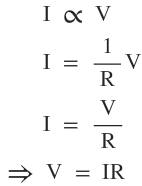Ohm’s Law Definition
Contents
show
The current flowing through any conductor is directly proportional to the potential difference between two endpoints of the conductor at a constant temperature.

where, ‘R’ is a constant known as the resistance of the conductor.
The Ohm’s law can be applied to both AC and DC circuits.
Limitations of Ohm’s law
1. It does not hold good for non-metallic conductors such as silicon carbide. The law for them is
V = KIm
where K and m are constants.
2. It does not hold good for non-linear devices such as zener diodes, voltage regulators, etc.
3. This law cannot be applied to the networks containing unilateral elements.
